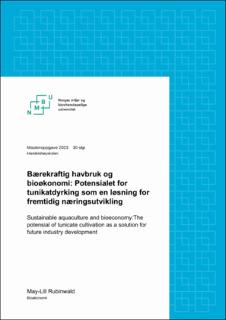| dc.contributor.advisor | Thore Larsgård | |
| dc.contributor.author | Rubinwald, May-Lill | |
| dc.date.accessioned | 2023-10-04T16:27:12Z | |
| dc.date.available | 2023-10-04T16:27:12Z | |
| dc.date.issued | 2023 | |
| dc.identifier | no.nmbu:wiseflow:6866299:55029661 | |
| dc.identifier.uri | https://hdl.handle.net/11250/3094203 | |
| dc.description.abstract | For å kunne forsyne en forventet global befolkning på 9,1 milliarder mennesker innen 2050, må matproduksjonen økes med 70% i forhold til nivåene fra 2010. Jorden har en biologisk produksjon som er omtrent jevnt fordelt mellom land og hav, men bare 2% av menneskers kaloriinntak og 15% av proteininntaket kommer fra havet. Med verdens nest lengste kystlinje, kan Norge forsterke sin sentrale rolle i å møte globale utfordringer knyttet til å forsyne den voksende verdensbefolkningen med nok mat. Økt fokus på lavere nivåer i næringskjeden og utvikling av bærekraftige løsninger for å forbedre produksjonen vil være avgjørende for fremtidens marine matproduksjon. Det vil også være nødvendig å dyrke og høste fra lavtrofiske marine kilder for å produsere mat, fôr og energi. Gjennom forpliktelsene inngått i COP15, har Norge forpliktet seg til å verne 30% av hav- og landområder innen 2030, noe som fordrer effektiv arealbruk ved en økt satsing på marine aktiviteter. Det finnes mange uutnyttede lavtrofiske marine ressurser i Norge, inkludert tunikater, som absorberer næringssalter fra havet gjennom sine filtrerende egenskaper. Tunikater bidrar til reduksjon av eutrofiering gjennom opptak av næringssalter fra akvakultur og landbruksavrenning. De inneholder også høyverdig protein og omega-3 fettsyrer, samt cellulose, som kan brukes i fôr, næringsmidler, biogass og biomedisinske applikasjoner. I denne studien ble det gjennomført kvalitative, semistrukturerte intervjuer med eksperter innen havbruk. Forskningsresultatene viser en positiv holdning til tunikatens økosystemtjenester og samdyrking med blant annet tare og fisk (IMTA). Tunikater kan dermed inngå i integrert havbruk med andre næringer, noe som både kan bidra til effektiv arealutnyttelse og en sirkulær økonomi gjennom opptak av næringssalter fra fiskeoppdrett (IMTA). Slike egenskaper kan bidra til det grønne skiftet, da tunikater kan gi bærekraftig protein både som næringsmiddel og fôr, samt redusere eutrofiering ved opptak av næringssalter fra akvakultur og avrenning fra jordbruk. | |
| dc.description.abstract | In order to cater to the anticipated global population of 9.1 billion people by 2050, it is projected that food production must increase by 70% relative to the levels recorded in 2010. The Earth's biological production is approximately evenly distributed between terrestrial and marine sources, yet a mere 2% of human caloric intake and 15% of protein intake is derived from the ocean. Possessing the world's second-longest coastline, Norway is poised to reinforce its pivotal role in surmounting global challenges associated with feeding the burgeoning world population. An intensified focus on lower trophic levels and the development of sustainable solutions to augment production will be imperative for future marine food production. It will also be necessary to cultivate and harvest low-trophic marine sources for the production of food, feed, and energy. Through the commitments undertaken in COP15, Norway has pledged to conserve 30% of its marine and terrestrial areas by 2030, necessitating effective spatial management through increased emphasis on marine activities. A plethora of untapped low-trophic marine resources exist within Norway, inclusive of tunicates, which assimilate nutrient salts from the ocean through their filtering capabilities. Tunicates contribute to eutrophication reduction by absorbing nutrient salts from aquaculture and agricultural runoff. They also contain high-quality protein and omega- 3 fatty acids, in addition to cellulose, which can be utilized in feed, nutrition, biogas, and biomedical applications. In this study, qualitative, semi-structured interviews were conducted with professionals possessing expertise in aquaculture. The findings revealed a favorable disposition towards the ecosystem services provided by tunicates and their co-cultivation with entities such as seaweed and fish (Integrated Multi-Trophic Aquaculture - IMTA). Consequently, tunicates could potentially be incorporated into integrated marine farming with other industries, thereby contributing both to effective spatial utilization and a circular economy through nutrient salt absorption from fish farming (IMTA). Such attributes could contribute to the green shift, with tunicates providing sustainable protein as both food and feed, as well as mitigating eutrophication through the absorption of nutrient salts from aquaculture and agricultural runoff. | |
| dc.language | nob | |
| dc.publisher | Norwegian University of Life Sciences | |
| dc.title | Bærekraftig havbruk og bioøkonomi: Potensialet for tunikatdyrking som en løsning for fremtidig næringsutvikling | |
| dc.type | Master thesis | |
